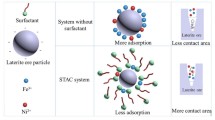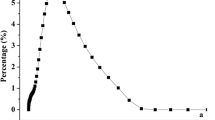Abstract
Sulfur dioxide (SO2), prevalent in the modern urban environment of industrial countries, attacks calcite (CaCO3)in marble. As a result, a gypsum (CaSO4·2H2O) crust is produced at rain-sheltered surfaces while areas exposed to rain experience accelerated erosion. We have investigated theeffect of certain surfactants as protective agents against SO2 attack. We report that the anions oxalate (C2O4 -2) and oleate (C17H33COO-) from solutions of their highly soluble alkali salt species areable to replace carbonate (CO3 -2) in calcite producingless reactive substrate of oxalate and oleate of calcium. Experiments to measure the protection obtained by these treatments were carried out in the laboratory and field conditions at nearly 1ppm and 10 ppb SO2 concentrations, respectively. We found that these treatments provided significantprotection to marble exposed in sheltered areas, up to 30% reduction of reaction rate by treatment with 2 × 10-4M sodium oleate and up to 14% by a 2 × 10-3 M with potassium oxalate solutions, but become ineffective over long term exposure when applied to surfaces exposed to rain.Carrara marble was used in the reported study. Ion chromatographywas the analytical tool, which allowed precise measurements of ionic concentrations of these salts, the amount of their uptakeby marble, and the thickness of the gypsum crust. X-ray diffraction allowed determination of the new minerals formed at the marble surface by the treatment with surfactants.
Similar content being viewed by others
References
Gauri, K. L., Popli, R. and Sarma, A. C.: 1982-1983, ‘Effect of relative humidity and grain size on the reaction rates of marble at high concentrations of SO2’, Durab. Build. Mat. 1, 209–216.
Gauri, K. L., Kulshreshtha, N. P., Punuru, A. R. and Chowdhury, A.: 1989, ‘Rate of decay of marble in laboratory and outdoor exposure’, J. Materials in Civ. Eng. 1, 73–83.
Gauri, K. L. and Bandyopadhyay, J. K.: 1999, Carbonate Stone: Chemical Behavior, Durability and Conservation, Wiley - Interscience, New York, 284 pp.
Hanumantha, R. K., Antti, B. M. and Forssberg, K. S. E.: 1988, ‘Mechanism of oleate interaction on salt - type minerals, Part 1, Adsorption and electrokineticstudies of calcite in the presence of sodium oleate and sodium metasilicate’, Colloids Surfaces 34, 227–239.
Thomson, G. and White, R.: 1974, ‘The pH of rain and the destruction of alkaline stone’, Studies in Conservation 19, 190–191.
Author information
Authors and Affiliations
Corresponding author
Rights and permissions
About this article
Cite this article
Böke, H., Lal Gauri, K. Reducing Marble-SO2 Reaction Rate by the Application of Certain Surfactants. Water, Air, & Soil Pollution 142, 59–70 (2003). https://doi.org/10.1023/A:1022016513965
Issue Date:
DOI: https://doi.org/10.1023/A:1022016513965




